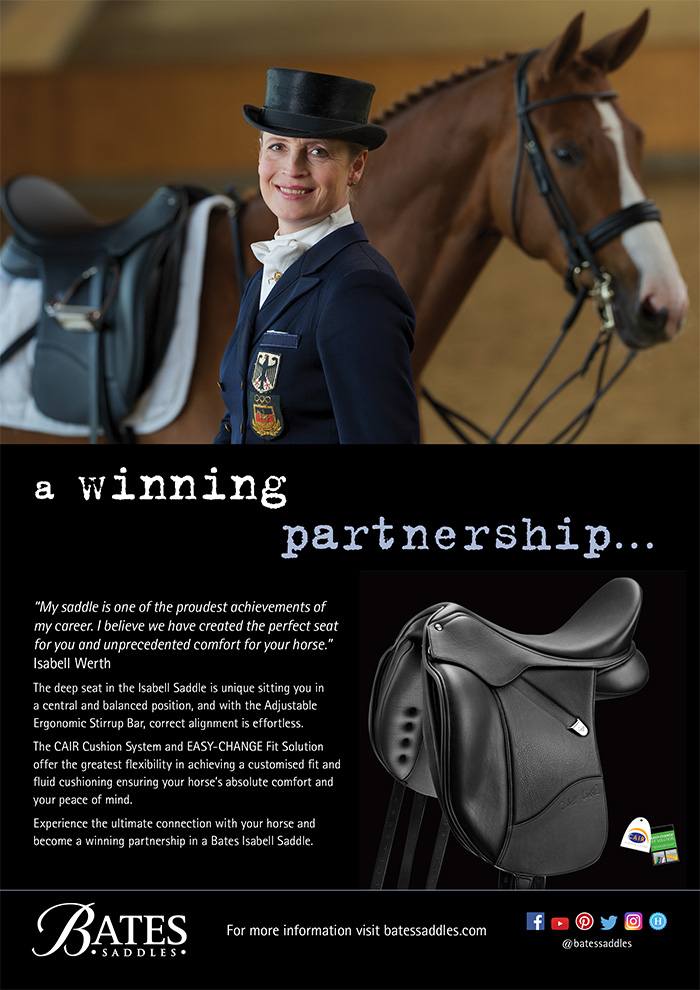Christopher Hector looks at the latest German breeding values – what stallions are hot right now?
The German FN breeding values have been released, again in the new format of one set of standings based on open competition results, and one on the young horse classes. I suppose there is nothing like a young horse to head the young dressage horse values. So the 2017 Nürnberger Burg-Pokal winner, Escolar (Estobar NRW / Fürst Piccolo) heads up the 2018 German FN values with a value of 174 but with a relatively low reliability figure of 90%.
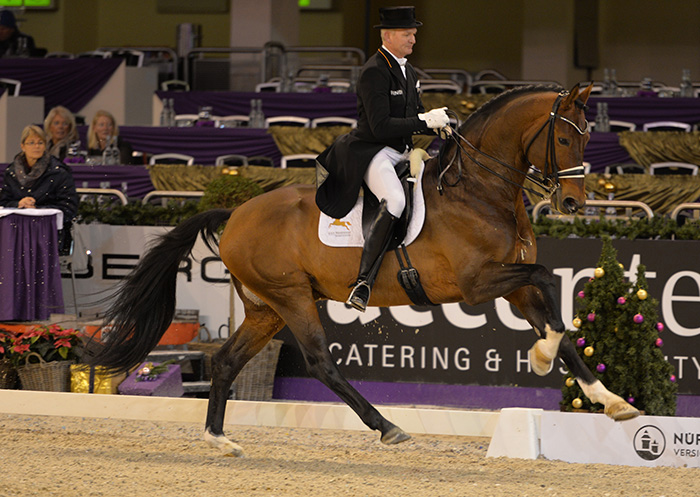
No 1 on the young horse rankings, Escolar
I draw on my friend Thomas Hartwig and his encyclopaedic knowledge of Westfalien breeding:
“We have seen in the last two or three years a very interesting comeback of the famous E line. The founder of the E line in Westfalia was Ehrenschild (Eindruck II / Adlerschild), a stallion from the Hanoverian State Stud in Celle, who came in 1960 to the town of Melle which is right on the border of Westfalia and Hanover, and the Westfalian breeders used him. He was a big, heavy horse, but typical of his time, remember he was born in 1956 and came to Melle in 1960 – for this time he was a typical horse.”
“He sired the Westfalian stallion, Ehrensold (Fronvogt), whose son was the very famous Ehrentusch (Rheingold). We saw a lot of very good children of Ehrentusch, and a lot of them have the same characteristics, they all want to work, they had all very good hind legs. They were not beauty queens – or kings – but perfectly usable, and not only dressage horses but also showjumpers. You might remember El Paso from Paul Schockemöhle and later Eddie Macken. In the 80s and early 90s, Ehrentusch was very favoured, but then a lot of people said, oh Ehrentusch’s children, they are not beautiful enough, and his popularity slipped down.”
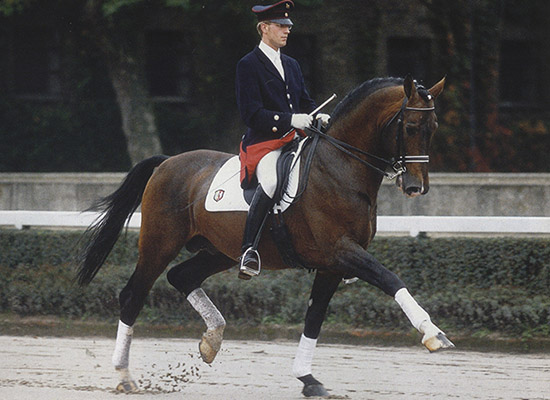
Ehrentusch – progeny ‘not beautiful enough’???
“Then one of the most famous breeders, Norbert Borgmann, the father of Stephan who runs the stud today, he used Ehrentusch with his very perfect mare, Florence (Ferragamo / Florestan) they produced Estobar, later Estobar NRW. He sold at the auction is 2006 for the unbelievable price of over half a million euros.”
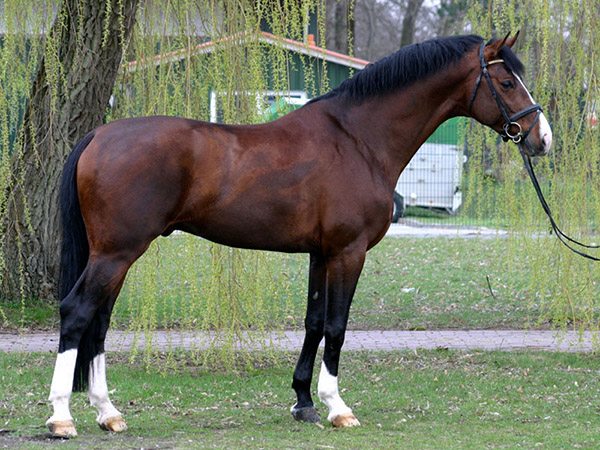
Estobar – saving the ‘E’ line
“From Estobar we saw his really best son, Escolar, two times winner at the Bundeschampionate as a three and four-year-old stallion where he received several tens for gallop and trot. Now we can see the first children of Escolar. The oldest are four but in the first season he covered only a handful of mares. The first crop we can really see are the three-year-olds and they have had a lot of success in Westfalia, and in the Bundeschampionate. The champion of the three-years-old geldings and mares class is an Escolar, Eternity who was shown by the stable of Andreas Helgstrand.”
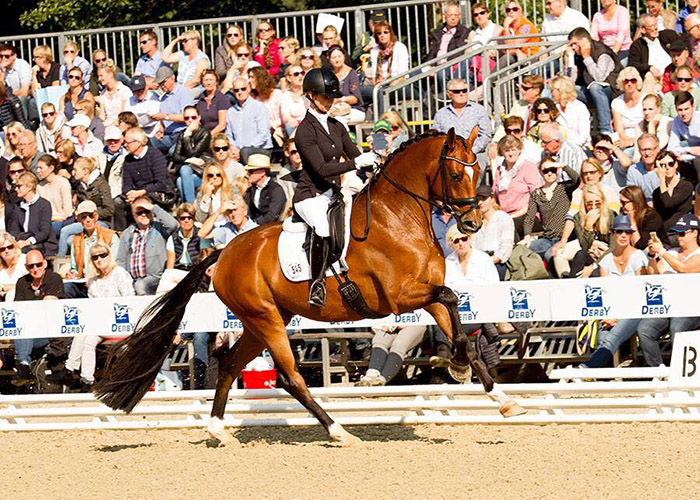
Eternity, another star at Helgstrand Dressage
“This story is a good example of two things. The first is, how great the danger is that a very valuable line can be forgotten – because if Norbert Borgmann hadn’t done his own thing with Florence, we would have had no Estobar, no Escolar, and no one would today speak about the E line. The second is that a lot of the strengths that were first seen with Ehrenschild, we can see three, four, five generations later. The very good hind legs, they all want to work, mostly not such beautiful horses but really horses you can use for working and working at a higher level, because they want to work.”
Since his win in the Burg-Pokal, Escolar has gone on to commence a very promising Grand Prix career. In November of this year, Hubertus and Escolar won the Munich Indoor CDI4* Grand Prix Friday in the stallion’s Big Tour debut, a day after riding the horse’s younger brother, Escorial to victory in in his first international Grand Prix at the same competition. Hubertus and Escolar scored 75.435 per cent for the victory in the Grand Prix for the Special.
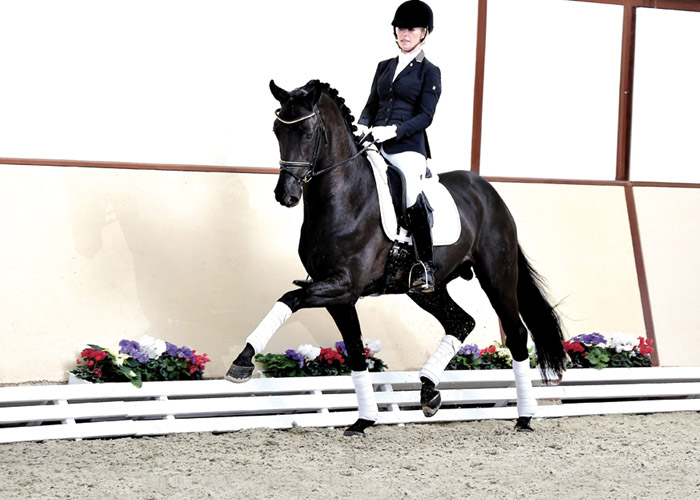
Fürsten-Look, young horse star…
The second highest ranked stallion on the new FN standings is not quite so famous, Fürsten-Look has a value of 170, with an even lower reliability score of 74. The youngster is by Fürstenball out of a Londonderry / Weltmeyer mare. His main claim to fame was a third in the Seven Year old World Young Dressage Horse championships in 2018 after winning the qualifying round. But there he is, the second highest rated sire of young horses. Once this sort of nonsense infected the whole of the FN values, now it seems confined to the sires of young horse competitors, which may be considered an improvement. It will be interesting to see how Fürsten-Look fares in the coming season after he has been revealed as a WFFS carrier.
Don Juan de Hus (Jazz / Krack C) comes in third on 168. The stallion was 6th at the 2013 World Young Horse Champs but ‘hoof cracks’ prevented his GP debut. He died in 2017 but not before he sired a couple of young horse stars. His son, Don Martillo (Benetton Dream FRH) won the 5 year old champs in 2017, but seems to have disappeared since then.
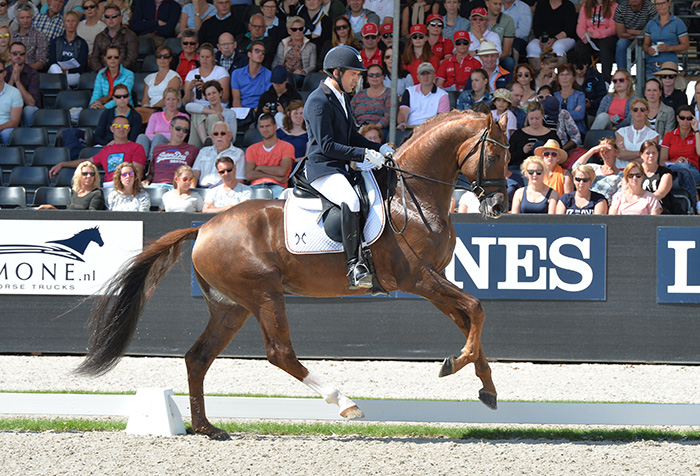
d’Avie (Don Juan de Hus/Londonderry) 6-y-o World Young Horse Champion
Another son, d’Avie (Londonderry) won the 6 year old champs the next year, while the interestingly bred, Dorien Grey de Hus (out of a Poetin clone) placed 5th in the 5 year old World Champs…
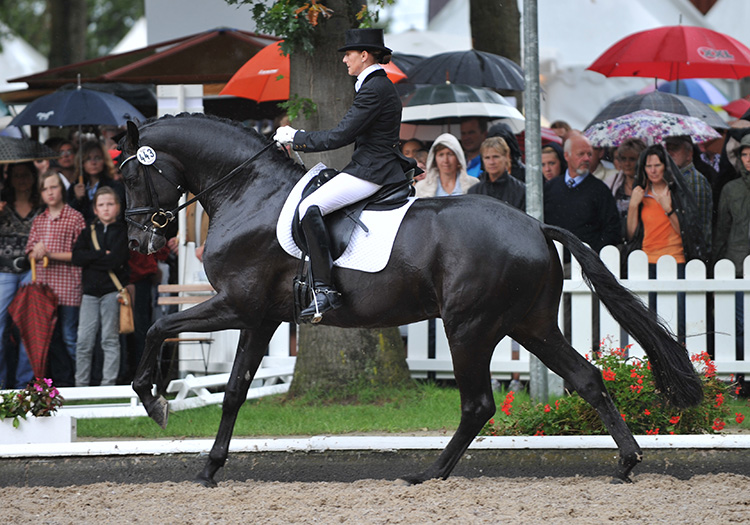
Fürstenball, performing at the Budeschampionat
Fürstenball (by Fürst Heinrich and out of a Donnerhall mare from the famed mare line of Georg Sieverding) comes in 4th on 162 (with an impressive reliability of 98%) and he is another who disappeared after his successful young horse career.
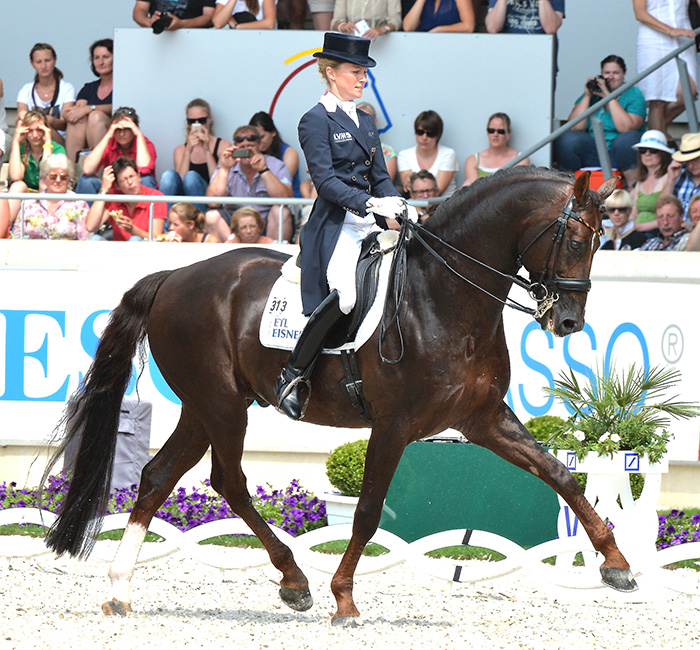
It is a relief to find Damon Hill (Donnerhall / Rubinstein) in 5th, a breeding value of 160, and 96% reliability. He truly is the odd man out, since he was not only a young horse star, winning both the 5 and 6 year old World Champs, but went on to be a World Cup and Olympic Games star, and he has sired some nice young horses, although we are still waiting for one to emulate the sire and cut it in the big sport.
My pal, Dr Ludwig Christmann, the head of the Hanoverian Verband’s Department of International Affairs, suggests that I am being unfair:
“To defend the breeding values, when you look at the data that is behind the breeding values, Fürsten-Look’s oldest offspring are three years old, so this is only data from five mares in the mare performance test, this is the minimum for a stallion to be published – there need to be five offspring, either in competition, or stallion testing or in mare performance tests. So this breeding value of Fürsten-Look comes because he was a super successful horse, he was Bundeschampion, and he was third in the World Championships, as a seven-year-old he already won on S level, so his breeding value now reflects more his own performance than the performance of the offspring.”
“Then there is Don Juan de Hus, this is not so crazy, he has produced super horses like Don Martillo.”
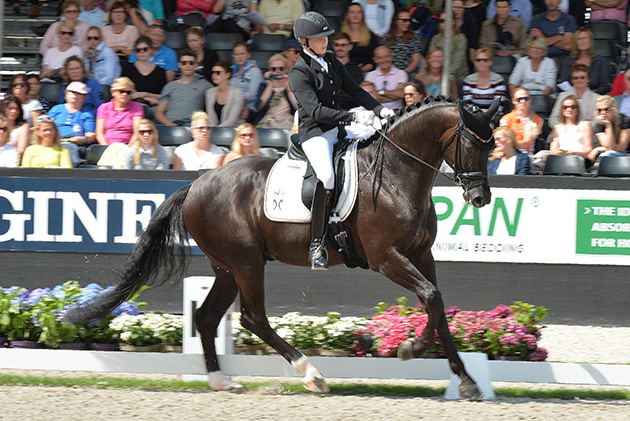
Don Martillo – ‘super horse’
We have to go down the list to fifth before we get Damon Hill, that’s the first stallion in the list who has actually done a Grand Prix test…
“But as you know, there are two lists, and this is the list for stallions with performers in the young horse classes, and this does not include the Grand Prix, so this is just based on young horse classes and performance tests, so I think the ranking is not so bad. If a stallion has a breeding value of 147, then he belongs to the 1% best and if a stallion has 148 or 149 or 150, this is not so important, so I think you should go a little bit away from the detailed ranking if the stallions are only two or three points apart from each other. Next year you get more information and a new breeding value, but it is already a strong statement when you have a breeding value of 140 or more.”
Enough of this nonsense, let’s look at the top German FN’s 50 sires of horses in open competition to see if we can find some reality. And we do, heading the standings for the second year running is Breitling W on a score of 166. Once again we lament the failure to measure success over the number of foals, since Breitling produced an extraordinary number of Grand Prix competitors, out of a very very limited number of mares. Why? Because he was far from fashionably bred, by Bismark out of a mare by Maat I, and he was not really the modern super elegant type. Still the chestnut stallion was a good Grand Prix performer with Wolfram Wittig, who championed him throughout his career, and with Wolfram’s half Thoroughbred mare, Diego, produced an astonishing seven international level dressage competitors.
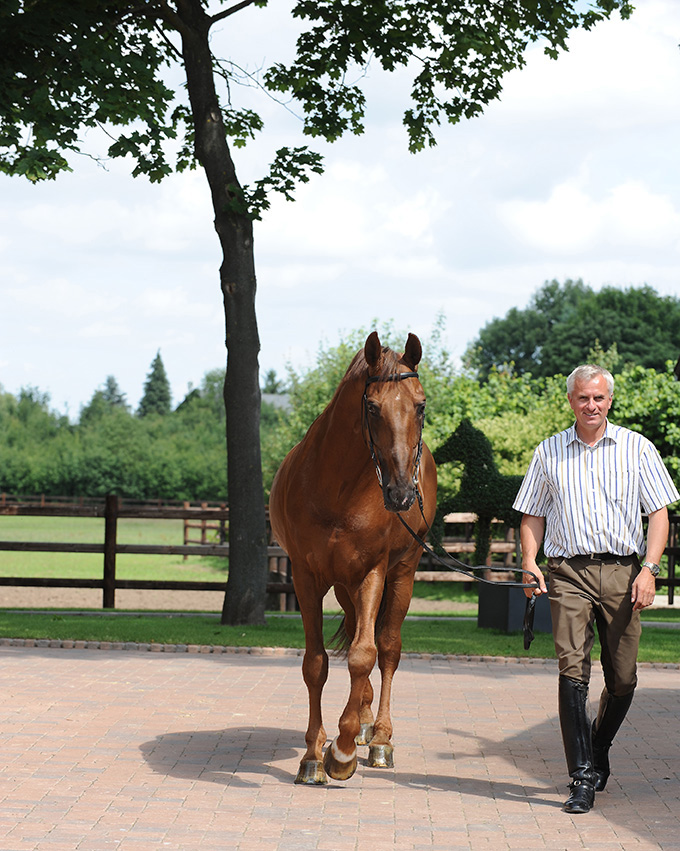
Wolfram Wittig and Breitling
Wolfram Wittig who ‘made’ the chestnut stallion, is, not surprisingly, delighted to see Breitling ranked number one again:
“We are delighted that his children has been so successful. And now Kira (Wolfram’s long term, coming up to 20 years, pupil, Kira Wulferding)has another very good one, five years old, it is owned by Victoria Max-Theurer, and it is an up-and-coming young horse.”
Do you know how many mares he covered – he must have the highest ratio of foals to Grand Prix competitors of any stallion…
“I think so, but we don’t have all the information, but I know his average must be very very high. The most mares he ever covered in one year was about 80 when he was placed at Schockemöhle’s, that was the maximum…”
And some stallions covered 800 in one year…
“What is important is not to sell the semen, what is important are the products, and what is so good about him is that he produced useful horses.”
For a long time people would say, oh, the Breitling progeny are successful because they are ridden by Wolfram and Brigitte, but now there are more and more horses that are being successful, with riders whose surname is not ‘Wittig’…
“We have very very good mares in breeding at my place. At the moment it looks to me as if our German breeding system just produces modern horses, not power, not potential, just modern horses, and for me, a horse is really modern if there is a blue ribbon on its head.”
When we look at the top horses in the sport – like Valegro, he’s not such a ‘modern’ type – like your Breitlings…
“No, but they are useful with a strong character, very good temperament, a very high level of rideability, this is what we are looking for. The next thing is that it takes a long time, the horse is seven or eight when you ask, is he good enough for Prix St Georges or Grand Prix, but at the moment in Germany, we are producing the foals to sell as foals. They need the dark colour, that is important…”
Flick their front legs with nice little tight backs…
“And we are not asking for good haunches for a good canter, and that is what is most important, canter quality.”
Who bred Breitling, you or your father in law, I see different versions…
“He took the mare to be covered so his name is written on the paper, but at the time, I was sending all our mares to Bismark (Bolero / Duellant). This year we have a seven-year-old who is by Boston (Jazz / Flemmingh) out of a Bismark mare, the Bismark mare was born in 1991. Brigitte competed the Boston in three competitions, Prix St Georges for two victories, and one second place. She has also been successful at Prix St Georges with another Boston, this time out of a Breitling mare. At the moment we are breeding with five Breitling mares.”
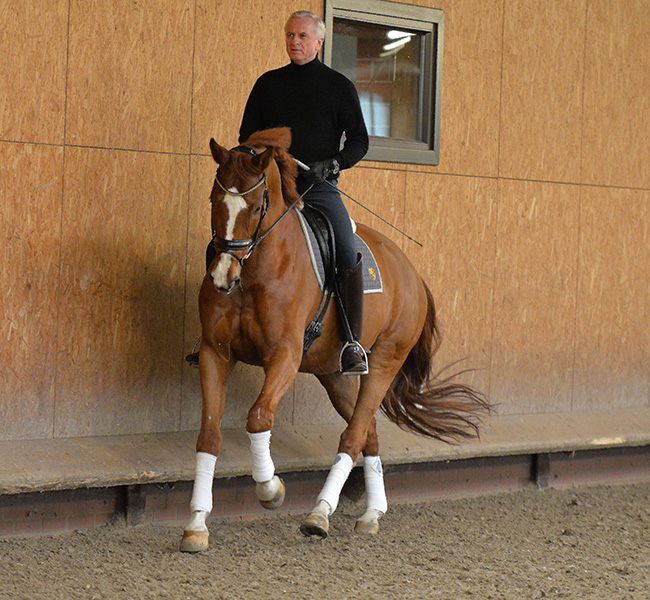
Wolfram and the 6-y-o Boston/Bismark at home
What stallions are you looking at this year?
“I was taking Foundation (Fidertanz / De Vito), he’s a very good stallion, then we have also used For Romance (Fürst Romancier / Sir Donnerhall I), Kira was in the Nürnberger Berg-Pokal final with him. This year I am also using Baron (Benicio / Sir Donnerhall I), more B line – back to Bolero. For me it’s important that I am independent with my mares, because the mares really have very good gaits, big fundament, big frame – so I don’t need a big stallion, and for me, 60% is based on the mare. I can make up my own mind when choosing the stallions.”
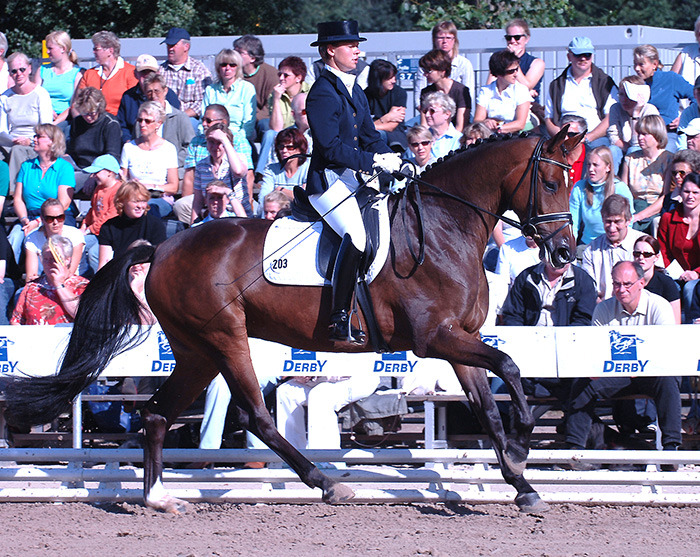
The C line representative, Cayenne W as a 4-y-o
So you are doubling up on the B line….
“I’m not intelligent enough to use the alphabet, I got stuck on the second letter. Once I used Carabas (Carnaby GL / Roberto), and bred Cayenne W (Bismark), a world champion, so I did get as far as the third letter.”
You didn’t get to D and Donnerhall…
“It didn’t work, even with DiMaggio it didn’t work and I liked DiMaggio (Don Primero / World Cup I), but it didn’t work, I couldn’t get our mares pregnant. That was the problem.”
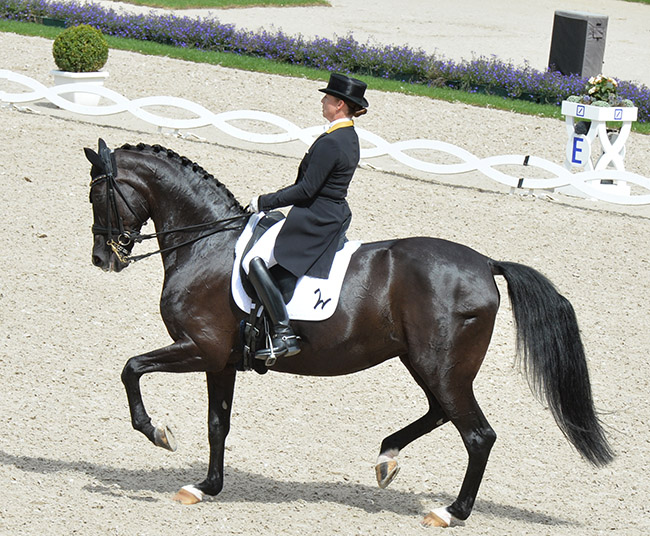
Weihegold, another hit for Don Schufro…
next we discuss Don Schufro
Not everyone has Wolfram’s problem with the D line, because there in second on the rankings with a breeding value of 165 is Don Schufro (Donnerhall / Pik Bube I) who first headed the FN values back in 2001.
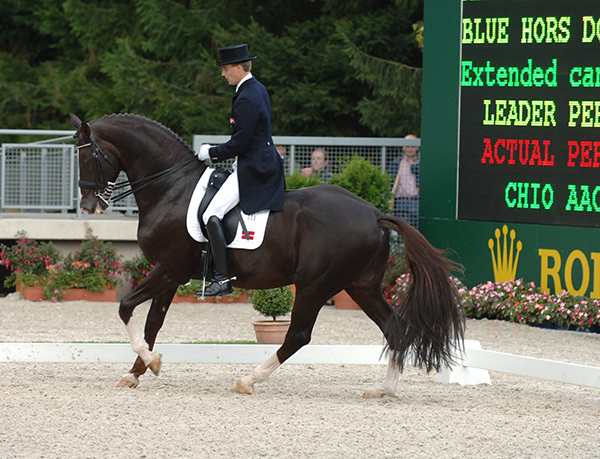
A young Don Schufro and a young Andreas Helgstrand
A Grand Prix star himself, Don Schufro had by the end of last year sired 232 competitors with winnings of €663,987, with the highest money going to Isabell Werth’s megastar, Weihegold (Sandro Hit). It has just been announced by Blue Hors that Don Schufro, who is no longer a breeding stallion, is a WFFS carrier, which raises the question, would it have been a good thing if the mare owners had known that 20 years ago?
Third to Damon Hill who we’ve already discussed in the other list on 164, tied with another who has also featured earlier, Fürstenball. In fifth place we have the doyen of Dutch dressage breeding Jazz (Cocktail / Ulster) with a breeding value of 163.
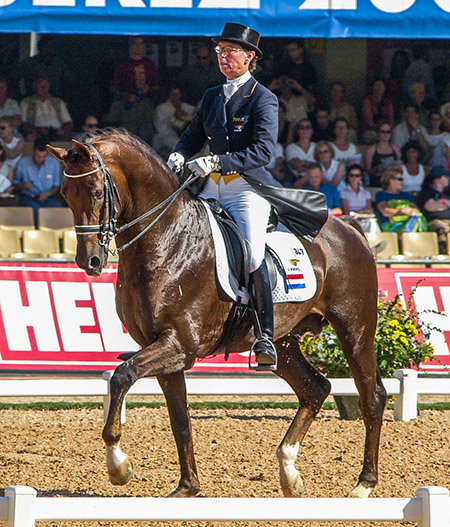
Jazz back in 2002, competing at the WEG with Tineke Bartels
Then the list starts to get loopy, on a breeding value of 161, we have Lissaro (Lissabon / Match aa) who was such a success as a sire that he is now a competition horse with a young rider. A truly great sire in Diamond Hit (Don Schufro / Ramino) scores 140 behind such breeding ‘legends’ as Lord Loxley I (Lord Sinclair / Weltmeyer – 150), three on 148, Dancing Dynamite (Don Bedo I / Fidermark NRW), DiMaggio, and Real Diamond (Rohdiamant / Weltmeyer), two on 147, Bordeaux (United / Gribaldi) and Flanagan (Fidertanz / Rubilo), Freudenprinz (Florestan / Franciso -146), Dark Fire (Donnerhall / Feiner Stern – 145) and Donnerbube (Donnerhall / Pik Bube I – 144).
Once again, Ludwig comes to Lisssaro’s defence:
“He has not been such a failure as a stallion, although he is definitely not the typical flashy foal producer. The first horses were produced in Westfalia, now we are getting the first horses Lissaro produced in Hanover and I have talked to many people who have ridden Lissaro offspring, or who bred Lissaro horses, and they are all very positive. Celle stands his son Labbadio (Dancier) who was 3rd at the Bundeschampionate for four-year-old stallions last year and he recently had the top mare in a mare performance test in Verden, from 40 mares, to mention just two positive examples.”
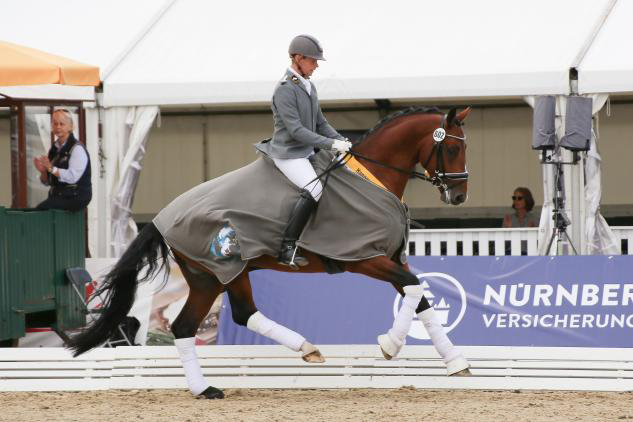
Labbadio, standing at Celle
I’ve seen some of them and they look like lovely scopey horses but not with the movement to be top dressage horses – I always thought he should have been an eventing sire because he had nice movement plus he could jump. I think they missed the market with Lissaro trying to sell him as a dressage sire…
“If a stallion wins the dressage at the Bundeschampionate three times and is reserve world champion, then of course you market him as a dressage stallion. As an eventer stallion, of course he would need blood mares because he himself is a substantial horse. He has produced some jumpers as well, so he is a versatile horse.”
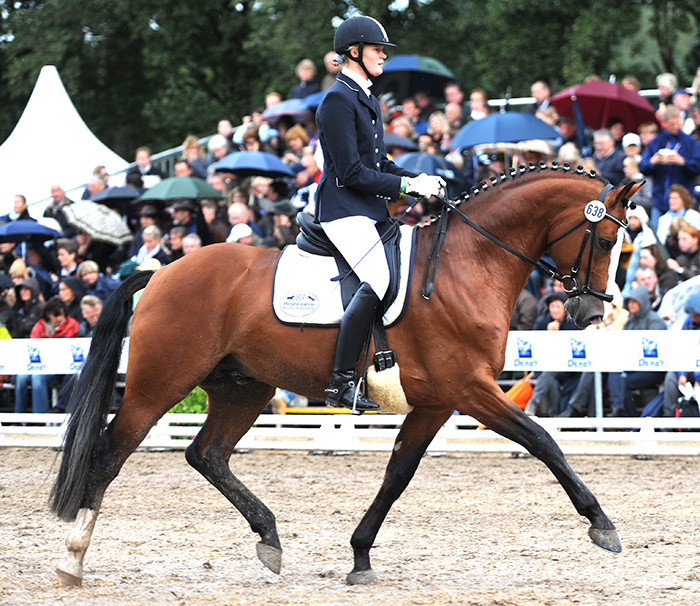
Lissaro, a versatile horse
“We have discussed this question and there are some rankings that are super and some that are a little questionable, but I do not think it is impossible to make them better.”
Will the FN rankings be better with access to international results, at the moment they are just based on German results?
“International results, yes, that would then include all the horses that are sold to America or elsewhere overseas and become successful on FEI level. There are changes being discussed.”
“Also the criteria for the breeding value is placings in competition, and here again, some changes are being discussed. There is research that looks more to the level of the competition, and this in my opinion, needs more consideration. But of course you cannot say anything against Breitling, Don Schufro and Damon Hill…”
When I look at the breeding values in Holland and in Germany, the breeders don’t pay any attention to them, you can have a horse at the top of the breeding values and still no-one breeds to it…
“I think the younger generation of breeders consider the breeding values more than the older generation.”
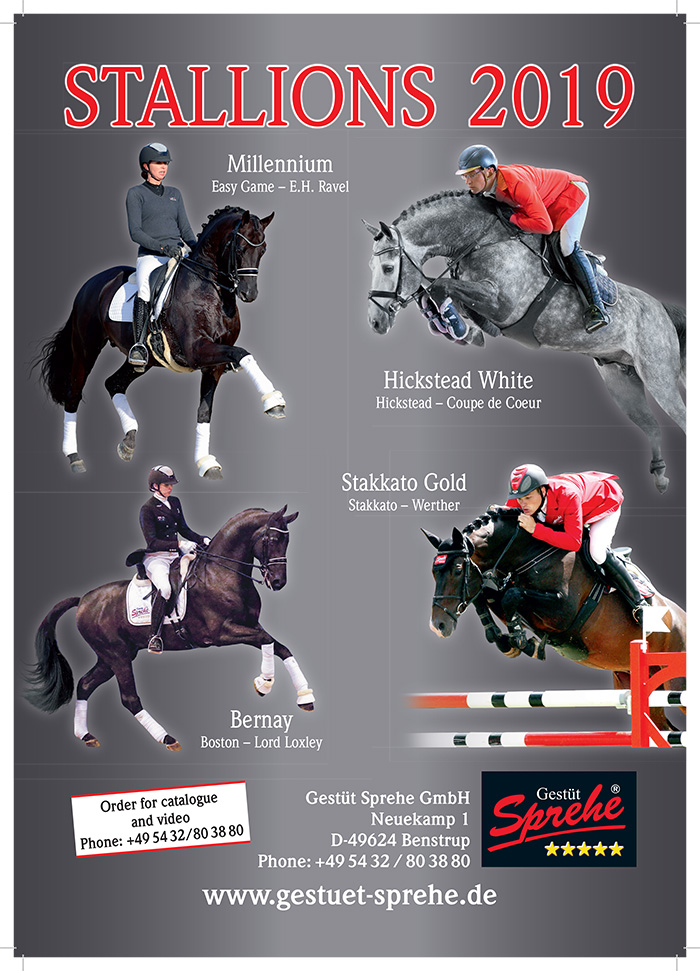
But still we are not getting any strong correlation between very good breeding values and lots of mares…
“I think there were some stallions that were ‘discovered’ through the breeding values. Stakkato Gold is one example – he was a relatively unknown stallion, then he was the highest in the breeding values. We started to do some research, and said, okay, he has really produced some fantastic offspring, and now he is considered truly one of the hottest of the younger jumping stallions.”
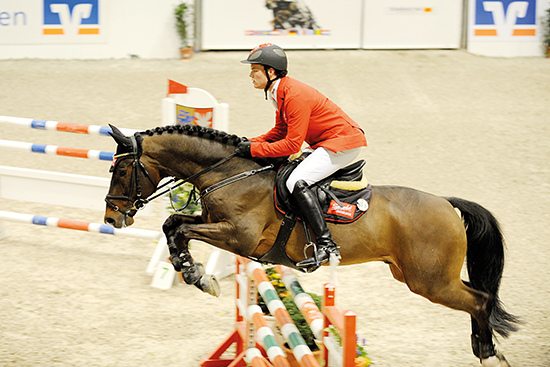
Stakkato Gold – ‘discovered’ by the breeding values
But there are so many factors that are so difficult to control – Stakkato Gold benefitted in that he stands at Sprehe, and they have a very effective marketing program and have a large following of mare owners…
“He also had a good background from his own performance and a good pedigree…”
His best performance was a placing in a nine year old class at Neumünster…
“But the pedigree is fantastic. By Stakkato, and the mother, by Werther, has competed internationally. And he was successful in the young horse classes, he won a big youngster championshipin Munich and then he was injured. I think he would have made a good career as a sport horse, when you look at the data, it is all positive. The breeding values discovered him and now he is one of the most popular stallions in Germany.”
I understand that this year’s Hanoverian Stallion Book suggests that Totilas is not such a wonderful sire of dressage horses…
“Totilas (Gribaldi / Glendale) has a dressage value of just 100 points on the results of the Hanoverian mare tests.” (100 is the base, anything below 100 is negative, and above positive, so Fürstenball who heads the Hanoverian standings, scores 150 – it takes a value of 120 to join the ‘topliste’ – CH).
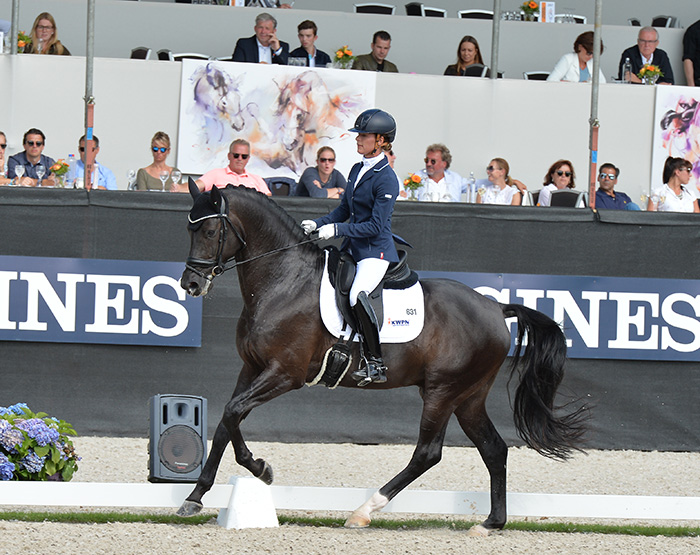
Governor, out of a sister to Parzival, and ridden by Adelinde Cornelissen at the WYH Championships
“I am always careful before I say that a horse will not be a good sire, there are some stallion sons of Totilas that are very promising, of course out of super mares – like the Dutch stallion, Governor out of the sister to Parzival.”
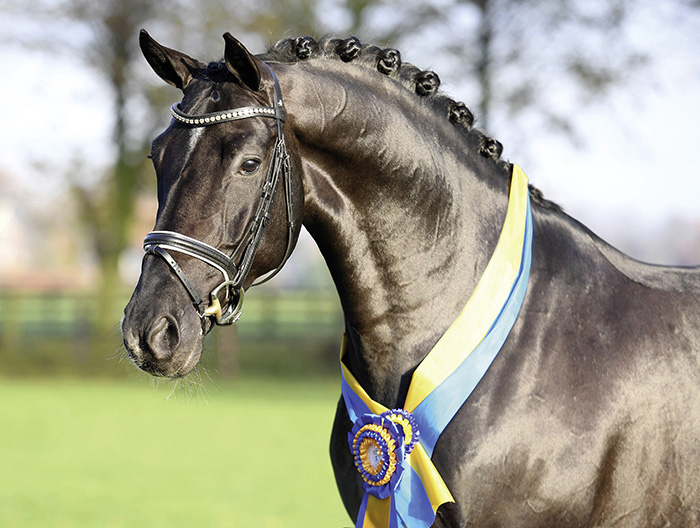
Total Hope, by Totilas, out of Isabell Werth’s Weihegold!
“And then there is Total Hope with Schockemöhle, he is out of Weihegold, there is another one Thiago out of the Grand Prix mare Wahajama standing at Schafhof stud. I have seen these sons and they are very talented for collection and so I am sure Totilas has produced some horses for the big sport. His breeding values so far are mainly based on the results in young horse classes and performance tests and we have to observe how the horses will develop, when they are getting older.”
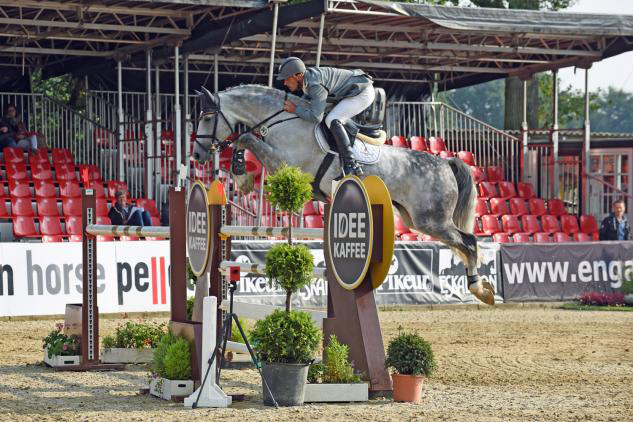
Diacontinus – heading the rankings
Time to look at the FN’s jumping breeding values and heading the list of sires of young horse class competitors, is not Stakkato Gold, he’s second with a breeding value of 159, but the Diarado (Diamant de Sémilly / Corrado I) son, Diacontinus (out of a Contendro I / Argentinus mare) with a value of 165. The usually reliable hippomundo database tells us that he has two competitors that have competed at the one metre level in four-year-old Young Stallion classes in Holland: Diadition (For Edition) who has won three times, and Diaro Gin (Silvio / Espri) who placed 54th and 61st at two of those three competitions.
more on the jumping sires follows
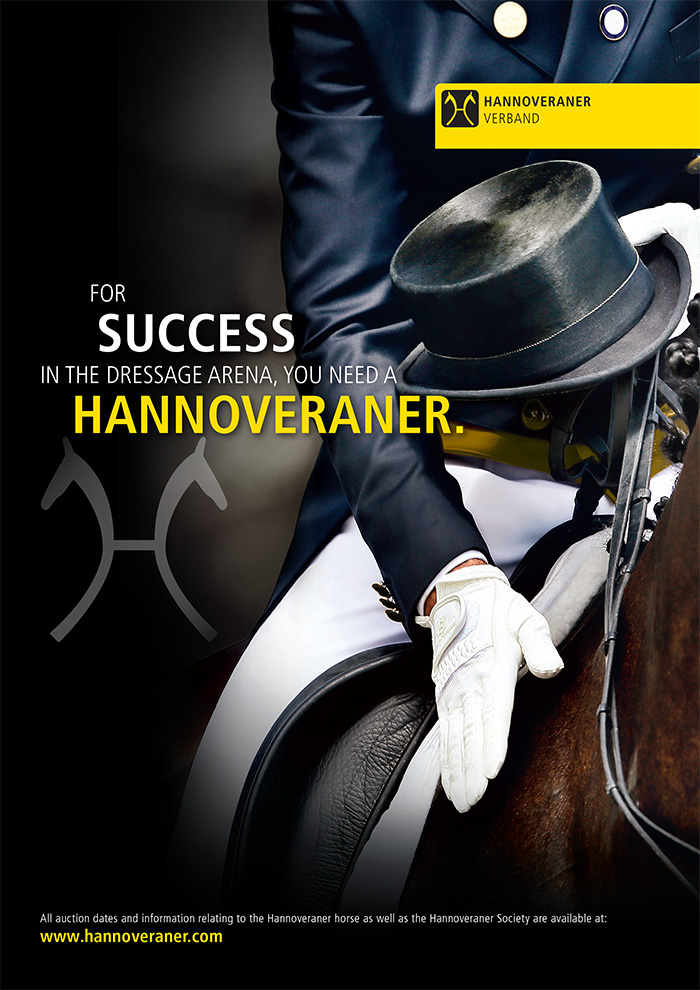
Once again, Ludwig Christmann:
“On the breeding values, Diacontinus is the highest ranked of the new stallions. He is by Diarado, but he is a different type from Diarado and he has produced very good foals.”
Diarado himself has been a flop in the competition arena, even coming from a stable that has produced top competition horses, he is not even competitive in 1.35/1.45 classes…
“But now he has produced some very good horses – Don Diarado, a Diarado son, for example,was named in the German team for the WEG with Maurice Tebbel.”
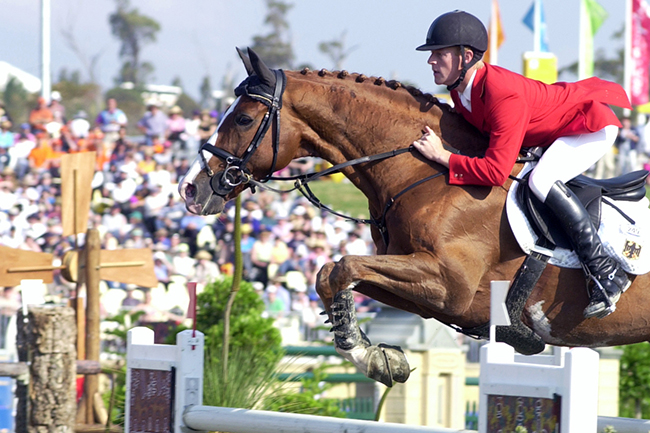
- For Pleasure, his progeny are careful, scopey and sound
“But you have to be careful, take For Pleasure for example, the breeders thought he was a super horse himself but not a producer, and he didn’t produce the horses for our young horse classes because they are not jumping in the desired style – they would never win at the Bundeschampionate – but they are careful, they are scopey, they are sound, and now he belongs to the top sires in the world. The For Pleasure bloodline is very important for Hanover, and the world.”
In equal third on 156, we have two horses that made their name with Eva Bitter, her grand old campaigner, Stakkato (Spartan / Pygmalion) and her more recent Grand Prix ride, Perigueux (Perpignon / Stakkato).
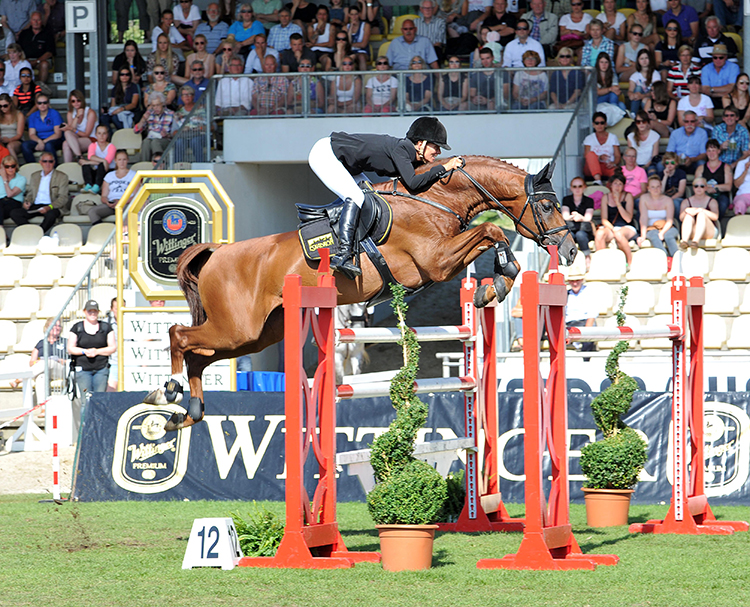
Eva and Perigueux
Eva herself says Perigueux is not really a 1.60 horse…
“I won a few Grand Prix. His level is up to 1.50m but there he does a perfect job. He is special, he always wants to give his best. He did 1.60 classes a few times, but this is not what he should do every weekend. He’s not the horse with the greatest scope, there are many horses with more scope, but what he’s won already, so many big classes where he was clear, this is something special already.”
What are the qualities he is giving to his progeny?
“They are so careful, they are so quick. Also they want to do good, they always want to work with you. They are interested not phlegmatic.”
How did you get Perigueux?
“I got him from the Hanoverian Stud, and I think it was a little that the rider before me didn’t believe in his scope. It was the end of the Young Horse classes for him, where they are just about style, and he had to go in the normal classes, like 1.30m and maybe they didn’t believe he had enough scope. It was difficult in the beginning because he was so hectic and then his stride got smaller and smaller. But even then the horse wanted to do the best he could at a show and that made it easier to get him right.”
“Sometimes you have horses with all the scope, and all the quality, but somehow they don’t work with the rider, they are always against, and then it is not possible to make a good horse.”
In fifth place on the jumping values we have an acknowledged super sire, Cornet Obolensky (Clinton / Heartbreaker) with a value of 154. Then four horses tied on 153, Cachassini (Cachas / Cassini I), Chacco Chacco (Chacco-Blue / Stakkato), Stanley (Stakkato / Loredo) and Grey Top (Graf Top / Singular Joter).
Ludwig is enthusiastic about the Celle based Grey Top:
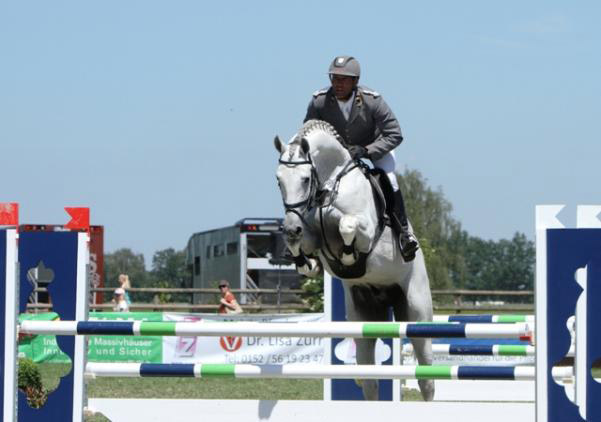
Grey Top – producing competitors…
“Grey Top is very promising. He did not jump 1.60 himself, but the State Stud has a disadvantage against the private studs, it is not a competition barn. There is a different task to fulfill, and it is not so easy to combine both. But when you look, Grey Top has produced around 600 foals for us, for 186 horses that are successful in competition – the oldest can only be on the third level – and there are 64 progeny already at 1.30 and that is a very high number. He has already produced the double Bundeschampion for eventing, Gentleman, that is a fabulous horse. We get good feedback from the riders, they are rideable, they are sound and they also have decent movement. I think he can be a good stallion to continue the Grannus blood, and the ‘G’ line.”
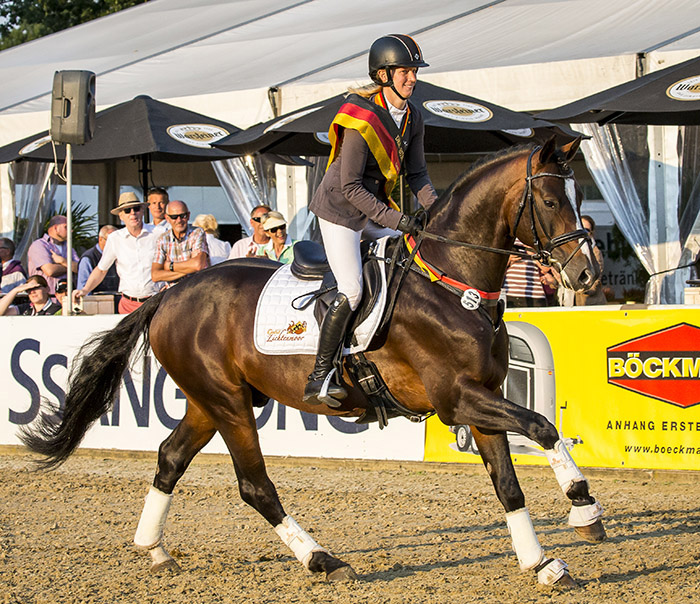
Sandra Auffarth and the exciting young eventer, Gentleman
As usual around this time of the year, Ludwig Christmann provides me with an English translation of his annual review of both the FN and Hanoverian breeding values. Here it is, enjoy:
DIACONTIUS IN THE LEAD
The end of the year is the time for summaries. That also applies to the breeding of horses. The year is being analysed and breed values are estimated with the help of an elaborate formula. The crucial word here is program. Through the breed value estimation, stallions are filtered out of an enormous amount of data. These stallions are expected to be of special value for the breed in certain well-defined criteria.
The German Equestrian Federation (FN) calculates the breed values for the disciplines of dressage and jumping. The breed value estimation of the Hannoveraner Verband also offers breed values for criteria regarding the exterior. The result of the breed value estimation for jumping is very gratifying from a Hanoverian perspective. Hanoverians dominate the breed value estimation for young horses; seven out of the top ten stallions carry the Hanoverian brand. Celle’s state stud sire Diacontinus was the highest estimated stallion. He pushed Stakkato Gold back onto second place.
The breed value estimation is a dynamic process. Every year new results are entered into the pool of data. A shift in the results of young producers is normal and to be expected. Last year, the data for Diacontinus was still relatively sparse. The breed value is solely based on the stallion’s own performance and on the results of a few mares, which completed the mare performance test. This year, the number of performance-tested mares increased to thirty, and, thirty-eight descendants competed in jumper horse classes from the first vintage of four-year old horses. Several of them even won jumping horse classes at 1.20 m. Young jumpers at that age could not achieve more. There certainly is hope that these young jumpers will advance and rise to do well as the demands increase.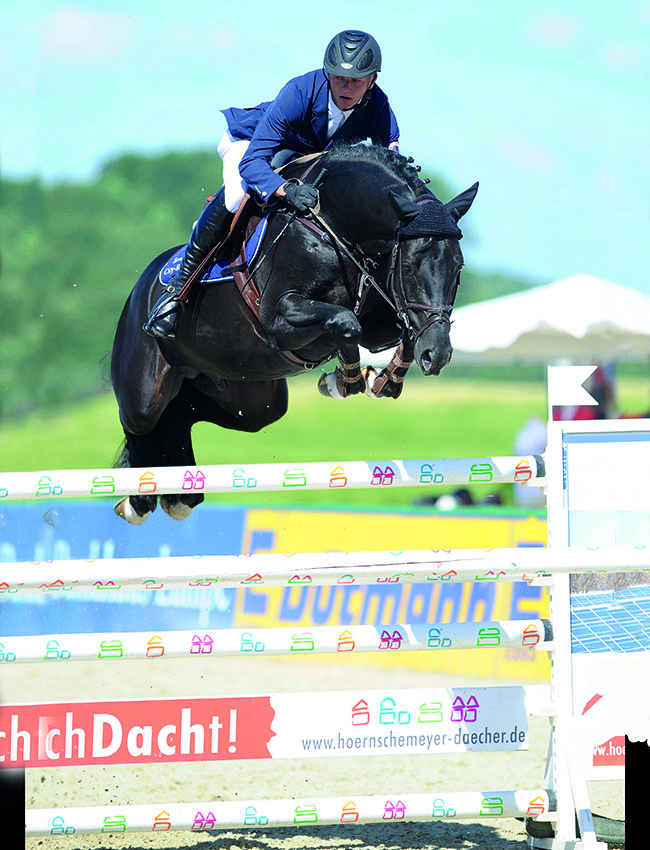
Diarado, sire of Diacontinus
Diacontinus is out of the proven breeding program of Klaus Juergens in Sehnde. This son of Diarado/Contendro represents the successful damline of Pension, which also produced Perigueux’s sire Perpignon. Diacontinus’ full-sister Diarada KJ successfully competes at 1.40 m with the breeder’s daughter Katharina Juergens. In 2012, she was the champion mare in the jumping discipline at the Herwart von der Decken-Show.
His other breed values also are positive. His FN-breed value for dressage, 128, is far above average. Diacontinus’ descendants are correct horses with good conformation and good toplines. They are of athletic type as the positive breed values from the mare inspections reveal. An interesting fact: A half-brother to Diacontinus by Stakkato was highly successful in jumping horse classes, before he became a dressage competitor. By now, Kerstin Simbuerger successfully competes him in dressage classes at advanced level.
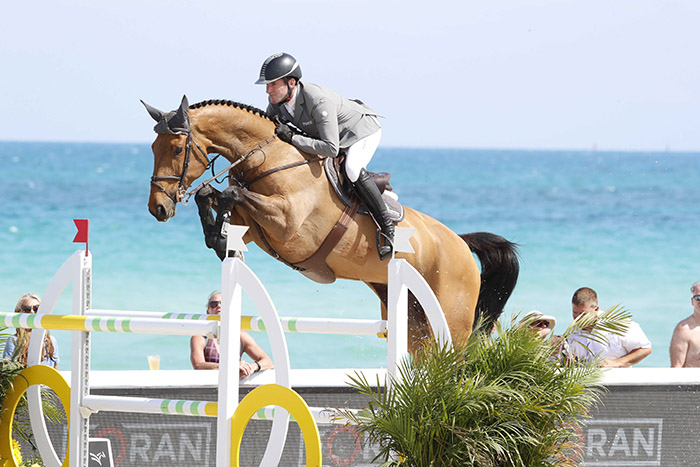
Winning at Miami Beach, Sansibar
Stakkato Gold is certainly well known as a member of the top group in the breed value estimation. By now, this son of Stakkato, which is stationed at Stud Sprehe, made a name for himself as a top international producer. Week after week, his offspring confirm his reputation on the big show grounds. His daughter Sansibar by Stakkato Gold/ Wolkenstein II is one of the current examples. With her rider Philipp Weishaupt, she was a member of Germany’s team, which won the tough Nations Cup at Spruce Meadows in Calgary. She furthermore won another international class in Spruce Meadows at the highest level. All statistics concerning Stakkato Gold’s heritability are impressive. The FN-computer recorded placements in jumping classes for 170 descendants including 51 – almost one-third – at the S-level, even though Stakkato Gold was not used much during his first years of breeding.
This record leads to the high breed value of 161 for competitions, which makes him the top German stallion in this breed value estimation. Stakkato Gold originates from the successful breeding program of Arend Kamphorst at the breeding farm Dree Boeken in Prieros. His heredity is also very well secured on the damside of his pedigree through the internationally successful jumper mare Wertherroeschen by Werther, whose dam descends from World Cup-champion Achill-Libero H.
Perigueux by Perpignon/Stakkato, another stallion from the State Stud Celle, follows in third place. Eva Bitter delivered inspiring performances aboard this wiry, typy chestnut stallion, which proved his jumping talent at the highest level. The results from mare tests contribute the most to his high breed value of 156. Fifty-seven daughters convinced with very good performances. He certainly must be viewed as a jumping specialist. The 2008-born Prinz out of a dam by Escudo (breeder: Volker Ebeling, Laatzen) is his descendant with the most winnings. Since October, Hans-Dieter Dreher very successfully competes him in international jumping competitions.
Interesting newcomers
Lord Fauntleroy by Lord Pezi/Contendro out of the breeding program of ZG Kern in Neuhausen, Baden-Wuerttemberg, is viewed as one of the interesting newcomers from the Hanoverian perspective. In 2011, the typey bay stallion was one of the striking jumper stallions at the licensing in Verden. In 2014, he won the Hanoverian jumper horse championships. Now Gilbert Boeckmann competes the stallion (owner: Wolfgang Brinkmann, Herford) internationally. Last spring, he won the Nations Cup in Uggerhalne, Denmark, with the German team. Lord Fauntleroy has not been used much for breeding. Hence his positive breed value of 149 is even more exciting.
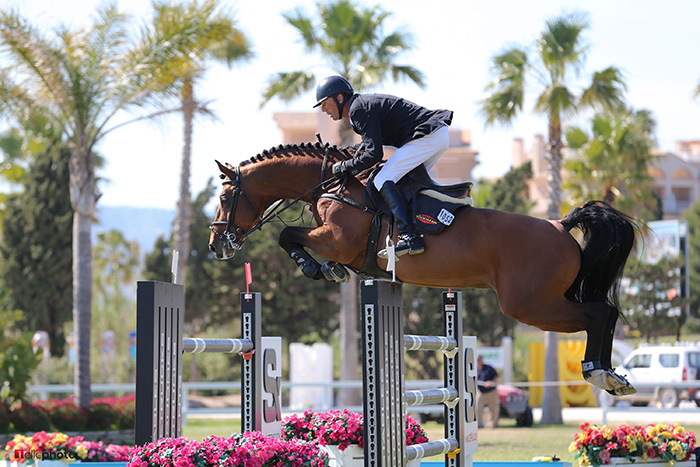
Lord Fauntleroy – exciting newcomer
The top ten-list of the breed value estimation regarding jumping competitions reads like a who-is-who of international jumping horse breeding. French and Dutch stallions dominate this list. The question whether the database of these producers is comparable to the one from stallions, which are used in Germany, certainly is legitimate. Most descendants of these “international stallions” were either imported or they competed on German horse shows with foreign riders. The more “normal” horses are missing, which every top producer also sires. These are the horses, which obtain average results on horse shows.
Here are the jumping breeding values tables. The six columns on the left are the Hanoverian values, The first three columns are the results based on mare performance tests and auction evaluations – column 1, jumping value; column 2, dressage value; column 3 – Genauigkeit = the reliability of the calculation – as the stallion has more progeny over his breeding career it becomes clearer how reliable the breeding value is, so in the case of Calido, it is very high 0.97, with some of the younger stallions, that figure is lower and more speculative; The next three columns are based on studbook inspections – column 4 – Reitpferdepoints/typ = typeyness; column 5 – Fundament = limbs; column 6 – Genauigkeit = reliability of the calculation. Columns 7 – 10 are the FN breeding values, and they take into account the stallion’s own performance as well as the performance of progeny. Columns 7 and 8, are the stallion’s jumping (Springen) breeding value, column 7 is the value based on results in young jumping horse classes, column 8 is from the results in open jumping competition. Columns 9 and 10 are the same, except that they are the values for dressage horses… Once again, the figure after the /, as in Calido’s score of 139/99, the 99 indicates a very high reliability, whereas with Stanley, 112/71, the 71 indicates that at this stage in the stallion’s career the reliability of the breeding value is not high. Got that?
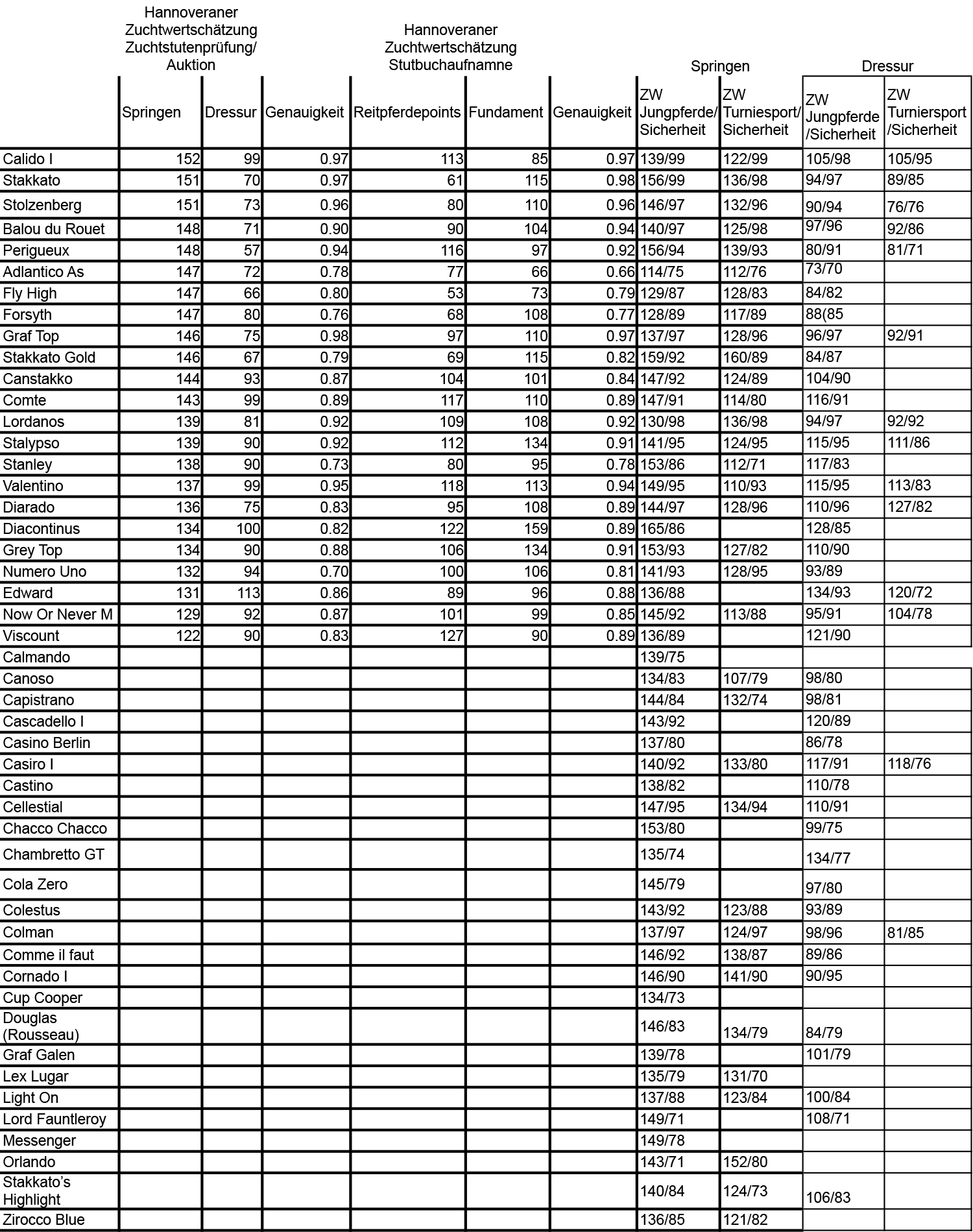
Breitling W holds the lead
Well-known horses head on the breed value estimation for dressage competitions. Breitling W by Bismarck/Maat (breeder: Hermann Niehus, Rahden), the Hanoverian Stallion of the Year 2014, obtained the highest breed value of 166 followed by Don Schufro, Damon Hill and Fürstenball. Two points separate each of these stallions. This fact underlines that all four stallions can be valued as almost equal with respect to their breed values, even though they are very different horses. The breed value estimation of the Verband spells out the differences very well.
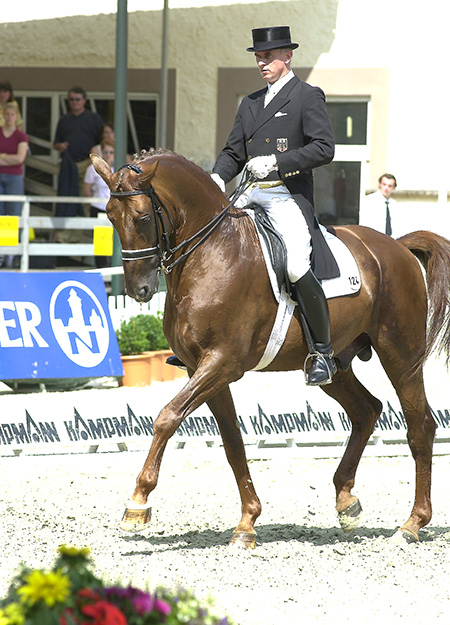
Breitling W, a legend, with Wolfram Wittig
Breitling W, Don Schufro and Damon Hill have already turned into legends. All three belonged to the group of the world’s best dressage horses during their time. While the competitive careers of Breitling W and Damon Hill were more in the forefront than their breeding careers, Don Schufro earned his far-reaching fame as a producer.
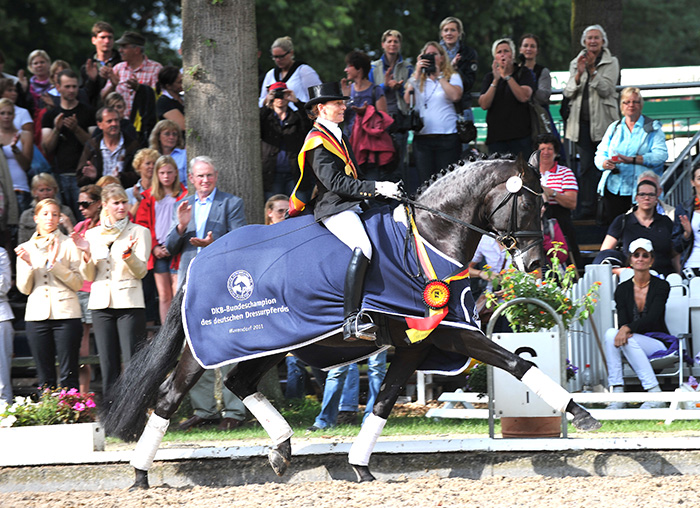
Fürstenball, Five-Year-Old Bundeschampion
Fürstenball, on the other hand, stands for the next generation. This son of Fürst Heinrich/Donnerhall is only twelve years old. The dressage Bundeschampion from 2011, which stands at stud at the Schockemoehle station, is one of the most popular young stallions in Germany. The breed values reflect this. The breed value for type shows that he reliably produces horses of the desired type, with beautiful heads and good frames. The dressage breed values verify three good basic gaits including an excellent walk and outstanding rideability. He already produced sons, which set about following into his footsteps. There is Follow Me from the sire’s first year of breeding, whose breed value estimation – young horse classes – is estimated at the very high breed value of 159. He was bred out of a dam by Donnerschwee, originates out of the Hanoverian damline of Sakaza I and stands at the dressage horse training center Loeningen. The mare performance test results of ten daughters produced the data for his high breed value as well as the results of two sons in their 14-day-tests for stallions and seventeen descendants, which competed in dressage horse classes at the A-level. Eleven of them won a ribbon.
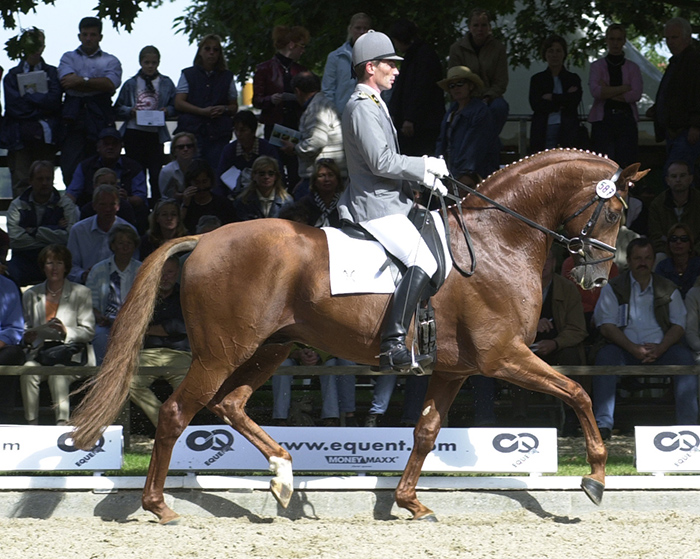
Londonderry, damsire of Fürstenlook and also a Bundeschampion
The seven-year old Hanoverian stallion Fürsten-Look is Fürstenball’s highest ranked son. Johannes Sabel from Gersten bred him out of St.Pr.St. Lady Diamond by Londonderry. The information for the breed value estimation from descendants is, as expected, rather sparse, since his oldest children are only three years of age. He reached the minimal requirement of five descendants for publicising his breed values because of performance-tested daughters. The results from riding horse classes are not considered; the minimum age for dressage classes is four years. Fürsten-Look’s high breed value is hence strongly influenced by his very own performances. As a four-year old, he won the Hanoverian Championship in Verden with Isabel Bache (later Freese) and became National Champion in the same year. In 2018, he successfully participated in the World Championships for seven-year old dressage horses. He won the introductory class and finished the final with winning the bronze medal.
Another son of Fürstenball ranks quite high with a breed value of 157. It is the stallion Finest (breeder: Andreas Trompeter, Sottrum), which stands at the stud W.M. His estimation is also foremost based on the results of daughters, which completed the mare performance test, and on his own performances in the stallion test and in competition. A considerable increase in descendants, which successfully compete and / or complete mare and stallion performance tests, is to be expected during the coming years for these young stallions, which might result in changes regarding the stallions’ breed values.
Broad genetic spectrum
Both top lists – regarding competitions and regarding young horse classes – reflect that there is movement in the genetic basis in the breeding of dressage horses in Germany. For many years, the trio W – D – R (Weltmeyer, Donnerhall, Rubinstein) was viewed as the pillars of dressage horse breeding in Germany. The genetic spectrum has considerably broadened by now. The line of Donnerhall continues to be very influential, especially through Donnerhall’s sons and grandsons like De Niro, Desperados, Dancier, Don Nobless, Diamond Hit, Don Frederico or Dimaggio. The importance of the branch of Florestan representing the Furioso xx-line strongly increased.
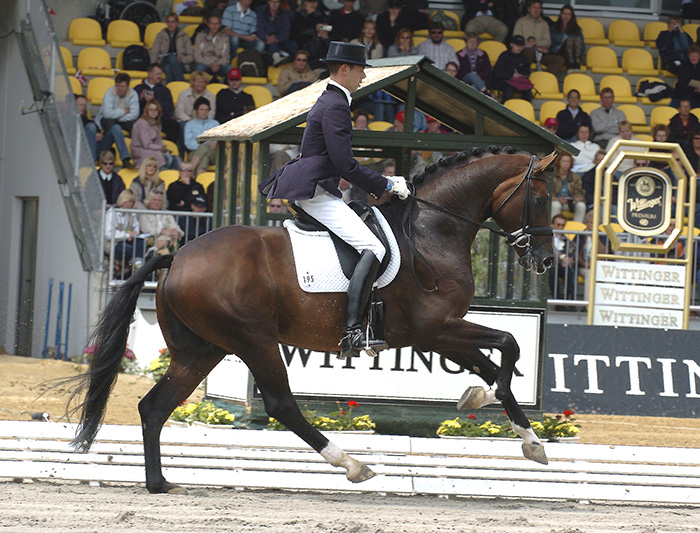
Florencio, representing the ‘F’ line
Stallions like Florencio, Fürst Heinrich and Fidertanz with their numerous popular sons and grandsons prove this fact. The line of the renowned Hanoverian Bolero once again plays a significant role especially via the Hanoverian Stallion Of The Year 2018, Belissimo M with his sons Baron and Benicio, but also via Benetton Dream and his son Bon Coeur, which delivered such a brilliant debut on the 2018 approval in Verden.
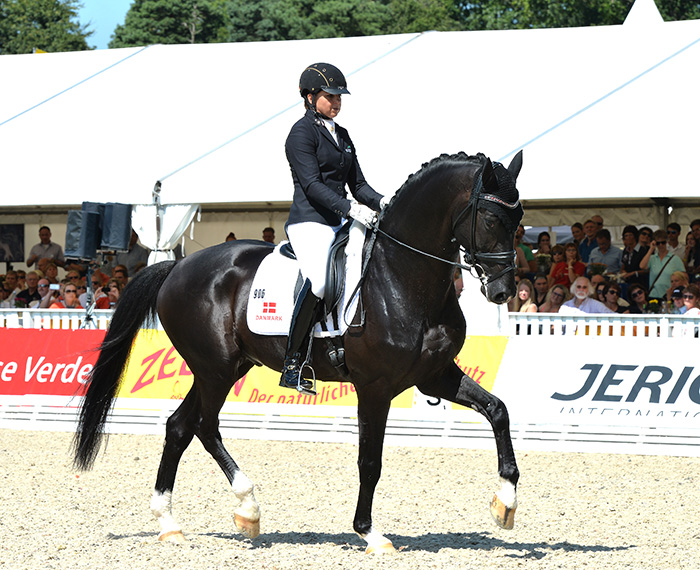
Sezuan, Dutch genetics, German rider, Dorothee Schneider
The top list of breed values also shows another trend, which became apparent at the licensings last fall nationwide: the growing importance of Dutch genetics. Five stallions with Dutch origin are now in both top lists: Jazz, Vivaldi, his son Vitalis, Don Juan de Hus and Sezuan. The blood of the Dutch producer legend Jazz is manifested in all of these stallions. Vivaldi by Krack C/Jazz demonstrates a very strong influence. With respect to his type and his movement, he can certainly be viewed as a stamping stallion. He produced the champion and the reserve champion mare at this year’s Herwart von der Decken-Show as well as this year’s top seller at Verden’s licensing, a two-and-a-half year old son out of a dam by Dancier. Dutch genetics add uphill movement, high knee action and a lot of expression in the dynamics of the front legs. Attention must be paid to maintaining a good walk, relaxedness, suppleness and a powerful hind leg, which should move under the center of gravity. How that is best achieved, is the question. Obviously in combination with the D-line, which we find in the pedigrees of Sezuan via the dam’s sire Don Schufro, of Vitalis via the dam’s sire Donnerschwee and of the two-year old top seller via Dancier. German dressage genetics are highly valued in the Netherlands, because they help improve the rideability.
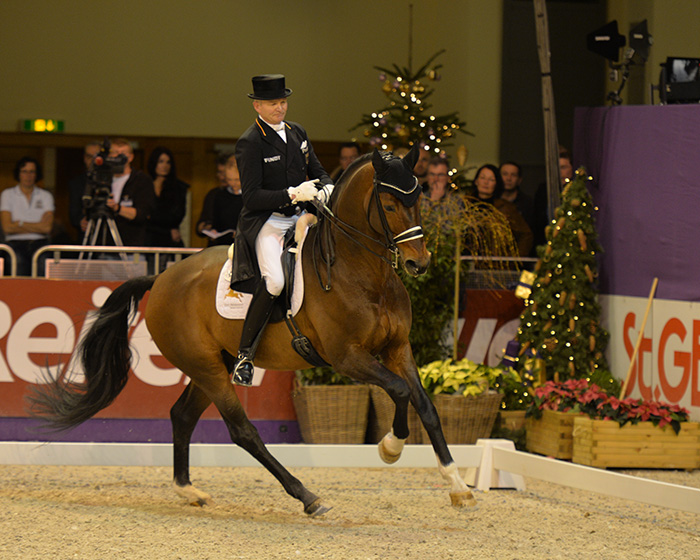
Escolar, Bundeschampion, and now competing Grand Prix
A stallion, which should have a great future in breeding and in the sport, takes the lead in the breed value estimation for young horse classes with a breed value of 174. We are talking about the Westphalian stallion Escolar by Estobar NRW/Fürst Piccolo, which goes back to the stallion line of Adeptus xx via Ehrentusch and Ehrensold. The now nine-year old Bundeschampion of 2012 and 2013 won the silver medal at the Nürnberger Burgpokal in 2017 and is one of Germany’s promising dressage horses with rider Hubertus Schmidt. A great number of approved stallions, highly decorated broodmares and successful offspring in young horse classes came out of his first years of breeding. Often a single stallion makes the difference instilling new life into a line.
The breed value of three time Bundeschampion Lissaro von de Helle by Lissabon/ Matcho AA (breeder: Juergen Dittmer, Neuenkirchen) stabilizes at a high level. FuN Dressage bought him as a dressage horse and Valentina Pistner rides him. The results of 111 descendants in regular competitions, 145 in young horse classes and 47 daughters in mare tests create a broad base for his breed value. While his first vintages mainly originate from his use as a breeding stallion in Westphalia, it now becomes apparent how valuable he is for Hannover. Often his descendants are imperturbable and have a dual predisposition. His son, the state stud sire Labbadio out of a dam by Dancier, placed third at the Bundeschampionat in 2018 and is a worthy successor.
Here are the dressage breeding values tables. Now I am sure you will have all memorised the translations I gave for the jumping tables, but just in case… here is the explanation again.
The six columns on the left are the Hanoverian values, The first three columns are the results based on mare performance tests and auction evaluations – column 1,dressage value; column 2, jumping value; column 3 – Genauigkeit = the reliability of the calculation – we see here Don Primero has the highest reliability, 0.96 – he is not discussed in Ludwig’s article because he is not actively breeding in Hanover, he died in 2012; The next three columns are based on studbook inspections – column 4 – Reitpferdepoints/typ = typeyness; column 5 – Fundament = limbs; column 6 – Genauigkeit = reliability of the calculation. Columns 7 – 10 are the FN breeding values, and they take into account the stallion’s own performance as well as the performance of progeny. Columns 7 and 8, are the stallion’s dressage breeding value, column 7 is the value based on results in young dressage horse classes, column 8 is from the results in open dressage competition. Columns 9 and 10 are the same, except that they are the values for jumping horses… Once again, the figure after the /, as in Fürstenball’s score of 162/98, the 98 indicates a very high reliability as a sire of young dressage horse competitors.
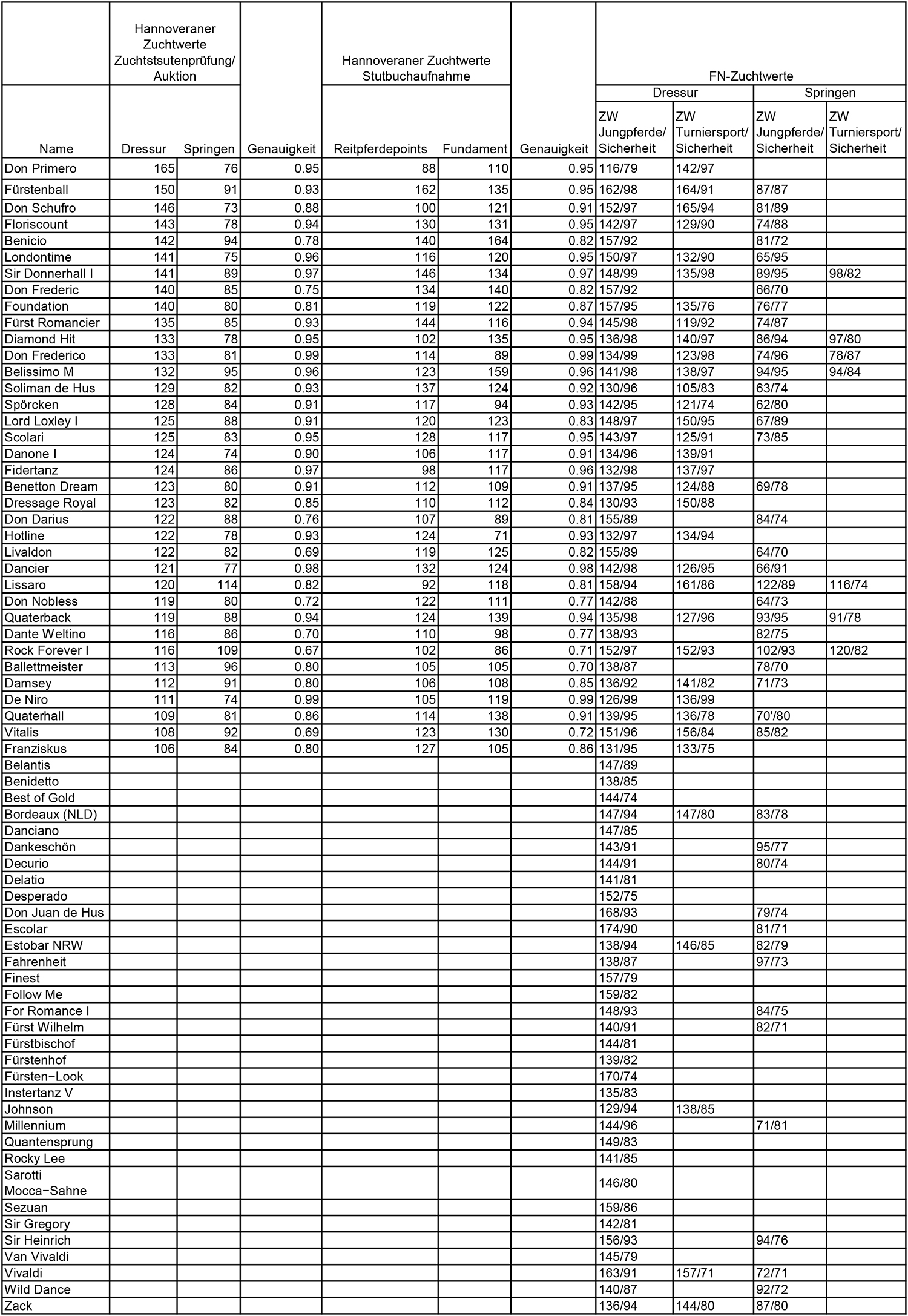
ends
Want to breed from the lines of the Top Hit Stallions right here in Australia? You can in 2019. Choose the bloodlines you would like to use to breed a top dressage, jumping or eventing lines from the range available from International Horse Breeders: www.ihb.com.au
Stallions like:

Total Hope
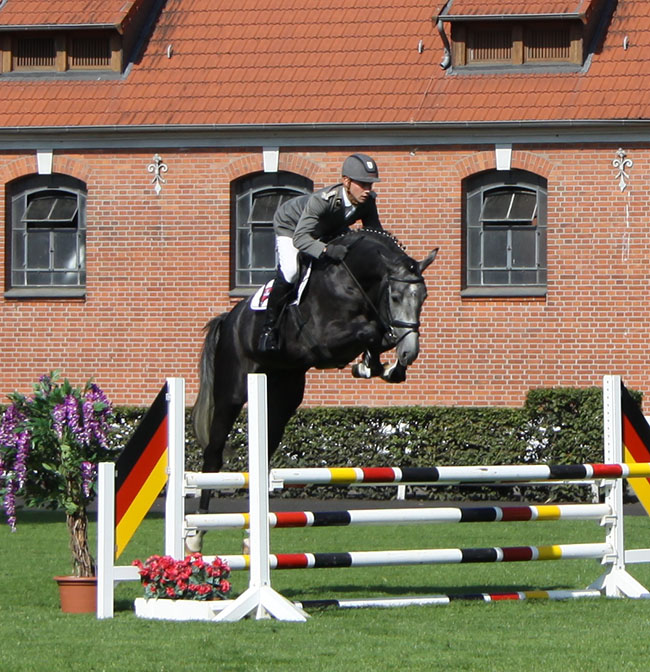
Diacontinus
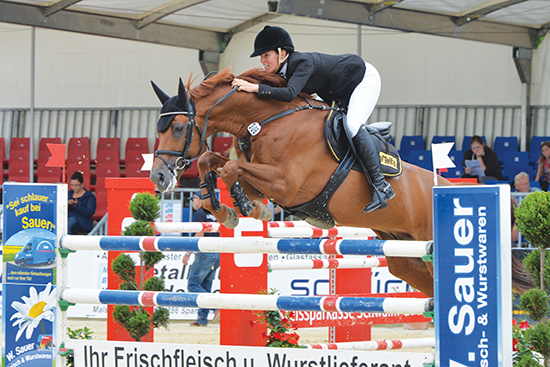
Perigueux




